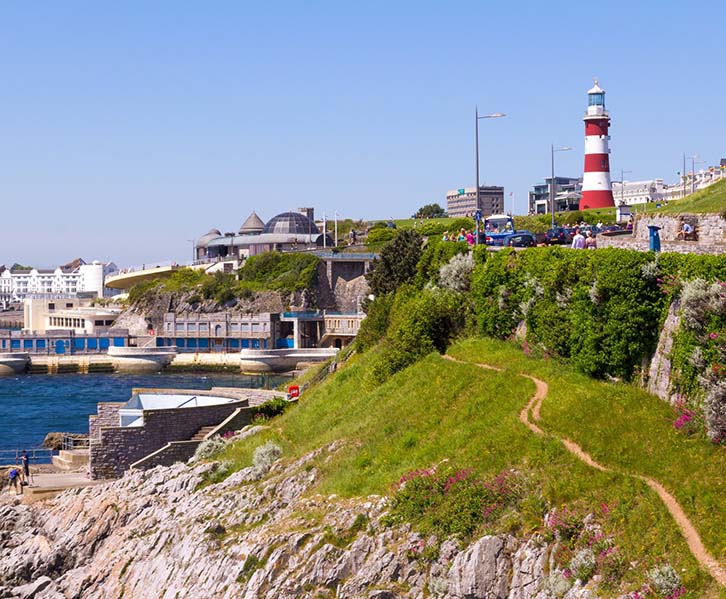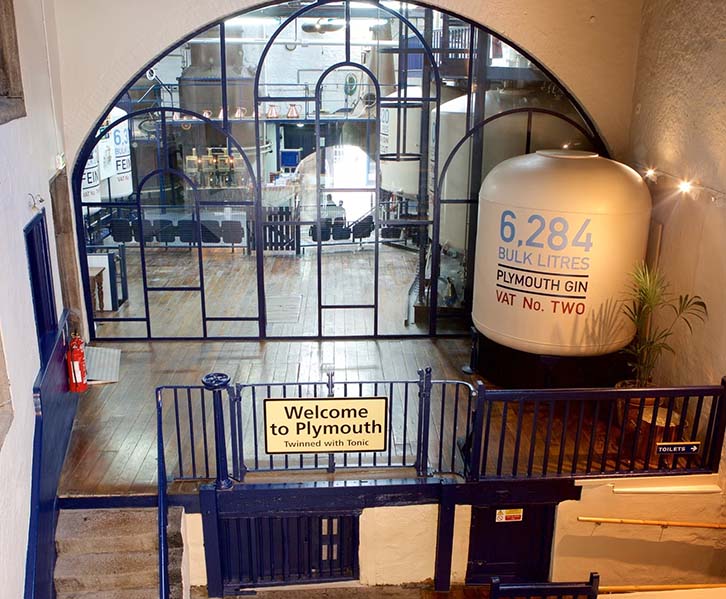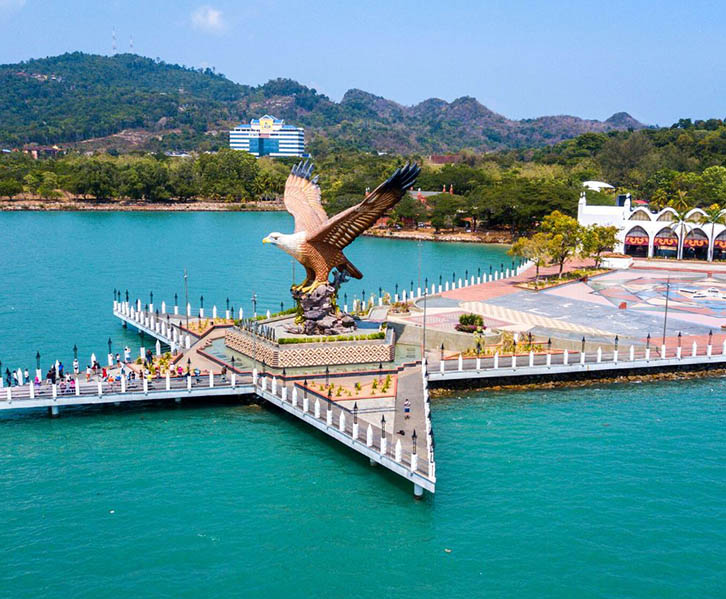Plymouth, Devon’s largest city, has a rich maritime heritage that has rightfully earned it the nickname “The Ocean City.” This title is well-deserved, given its historical significance as the departure point for some of the world’s most famous voyages. Notable expeditions launched from Plymouth include the Mayflower Pilgrims’ journey to the “New World” in 1620, Captain James Cook’s explorations in the late 1700s, and Sir Francis Drake’s renowned circumnavigation of the globe in 1577-80.
Situated on the sheltered Plymouth Sound, a deep inlet in south Devon, between the Rivers Plym and the Tamar on the Cornwall border, Plymouth is unmistakably a maritime city. It continues to house the largest Naval Base in Europe, solidifying its status as a significant port city.
Enjoy Scenic Seascapes and History at Plymouth Hoe
Plymouth Hoe, commonly referred to as The Hoe, stands out as one of the premier attractions in the city. This clifftop park offers breathtaking vistas of Plymouth Sound, extending all the way to the English Channel.

In addition to providing a delightful setting for a leisurely walk or a picnic, The Hoe boasts numerous monuments and landmarks that bear witness to Plymouth’s extensive maritime heritage and its significance as a crucial naval base.
Smeaton’s Tower, a renowned red and white lighthouse originally constructed on Eddystone Reef in 1759 and later relocated to The Hoe in the 1880s, stands as an unmistakable landmark. Nearby, the imposing Plymouth Naval Memorial serves as a tribute to the sailors who lost their lives during World War I and World War II and have no known resting place. Given Plymouth’s significant role as an embarkation point for the D-Day landings during WWII, it is important to pay your respects at this memorial.
Don’t miss Francis Drake
Sir Francis Drake, a complex historical figure, is also commemorated with a statue at The Hoe. Drake, a former mayor of Plymouth and one of the city’s most famous figures, is known for his dual roles as an illustrious explorer and a privateer (a legalized pirate). He is celebrated for being the second person and the first Englishman to complete a circumnavigation of the globe. However, as a privateer, Drake frequently conducted raids on Spanish colonies in the Americas, with the backing of Queen Elizabeth I.
Drake’s legendary status as a hero in the defeat of the Spanish Armada in 1588 is notable, although his history of piracy likely played a significant role in Spain’s decision to attack. The famous anecdote recounts Drake playing bowls on The Hoe when news of the armada’s approach reached him. His response was characteristically composed, stating that there was sufficient time to “finish the game and defeat the Spaniards too.”
Explore Plymouth’s Rich History at The Box
The Box, a relatively recent addition to Plymouth, exemplifies the city’s cultural renaissance. This state-of-the-art museum and art gallery delves deep into the multifaceted history of Plymouth, both past and present.

The architectural marvel of The Box combines the former museum, library, and St Luke’s Church buildings with modern grey-and-glass cubic architecture to create an expansive museum space at the core of the city’s emerging Cultural Quarter.
Admission to The Box is free, making it an award-winning and captivating window into Plymouth’s rich heritage and culture. The museum’s permanent exhibitions vividly portray Plymouth’s narrative and its significance as England’s “Ocean City.” A must-see is the “100 Journeys” exhibit, shedding light on the renowned voyages that have departed from Plymouth throughout history.
Additionally, The Box offers an engaging lineup of temporary art exhibitions, workshops, and diverse events, so be sure to check the schedule during your visit.
Explore Sutton Harbour and The Barbican
Sutton Harbour serves as a captivating backdrop, offering two distinct facets of Plymouth’s character on each of its shores.
During WWII, much of Plymouth suffered heavy bombing; however, a fortunate occurrence allowed a small historic enclave to endure. This area, known as The Barbican, consists of a labyrinth of cobbled streets bordered by charming buildings and unique boutiques. Be sure to explore the timber-clad Elizabethan House, which dates back to 1599 and is located on New Lane.
Sutton Harbour was the embarkation point for the Pilgrim Fathers’ third and final voyage on the Mayflower in 1620, marking the beginning of their journey to the “New World.” The Mayflower Steps Memorial designates the approximate point of departure, and the nearby Mayflower Museum provides in-depth insights into the voyage and its subsequent events.
Just a stone’s throw away, the Barbican’s former fish quay has been redeveloped into a trendy waterfront area adorned with contemporary apartment buildings, numerous bars, and restaurants. It’s a perfect place to savor a meal or drinks while gazing at the water.
Explore the Plymouth Gin Distillery
If you’re a gin enthusiast, a visit to Black Friar’s Distillery, the birthplace of Plymouth Gin, is a must while you’re in Plymouth.

Even if you’re not a gin enthusiast, a visit to Black Friar’s Distillery is worthwhile just to explore one of Plymouth’s oldest and most historic buildings. The Refectory Bar on the upper floor is located within a medieval hall featuring a distinctive hull-shaped timber roof constructed in 1431.
Originally serving as a monastery, Black Friar’s Distillery is the oldest operational gin distillery in England. This atmospheric structure has been the proud home of Plymouth Gin since 1793 and, at one point in history, supplied the Royal Navy with a purportedly medicinal Naval Strength gin.
You can plan a visit for a tour and gin tasting, or alternatively, drop by the bar for a drink. Tour prices start at £15 per person, and it’s recommended to book in advance.
Enjoy a Swim at Tinside Lido
Cherished by both locals and tourists, Tinside Lido stands as one of Plymouth’s most sought-after attractions. This Art Deco open-air saltwater swimming pool and sun deck, situated along the waterfront beneath Plymouth Hoe, offer breathtaking views of The Sound. Constructed in 1935, this stunning pool remains a beloved summer destination for many in the city.
Pro Tip: During the summer, it’s advisable to make advance reservations as the Lido tends to get crowded. The pool operates seasonally, typically from late May to the end of September.
Meet Local Sea Life at the National Marine Aquarium
Located adjacent to Sutton Harbour, the National Marine Aquarium is the largest of its kind in the UK. It stands out as one of the top attractions in Plymouth, particularly for families with young children.
Discover a multi-level aquarium housing a diverse range of marine life from England and various parts of the world. The main attraction is the colossal Atlantic Ocean exhibit, which is the deepest tank in the UK, holding an impressive 2.5 million liters of water. Inside, you can observe green turtles, rays, and several shark species. It’s an experience not to be missed.
The aquarium is operated by the Ocean Conservation Trust, which means that purchasing tickets contributes to funding conservation and research initiatives.
Hop on the Ferry to Mount Edgcumbe
Take a ride on a Plymouth Boat Trips ferry to access Mount Edgcumbe, a historic manor house and country park located just across the River Tamar in Cornwall!
Situated on the Rame Peninsula, the easternmost section of the Cornish Coast, Mount Edgcumbe is a delightful country park with a rich history dating back to the 1500s. Following restoration after WWII, it now graces a vast 865-acre Country Park complete with Grade-1-listed gardens and numerous scenic walking trails to wander through.
Make sure to explore the manor house, which houses a remarkable collection of artifacts and treasures amassed by the Earls of Mount Edgcumbe throughout the centuries.
The ferry service operates from the Barbican to Royal William Yard before proceeding to Cremyll Quay at Mount Edgcumbe. Alternatively, you can take the direct Cremyll Ferry from Admirals Hard in the western part of Plymouth.
Savor Culinary Delights at Plymouth Market
Plymouth has boasted a market since as far back as 1253. The present-day indoor Pannier Market, inaugurated in 1959 in the city’s West End, is currently undergoing a revival.

While the traditional market endures, the addition of more food stalls has given it a trendy food court ambiance, attracting a new wave of visitors. Be sure to sample some of the delectable offerings from these fantastic food stalls:
- Maurish – Serving homemade Mauritian cuisine
- Taste of Thailand – Offering authentic Thai dishes
- Soul Food – Serving Caribbean cuisine and refreshing rum cocktails
- @kitchen – Plymouth’s top-rated dining spot on TripAdvisor
- Everest Flavours – Delighting taste buds with authentic Nepalese street food snacks
- Tara’s Persian Food – Offering flavors from Persia
- KIKU – Providing authentic Japanese cuisine, including sushi and bento meals
Explore Maritime Heritage at the Royal Citadel
Situated at the eastern end of The Hoe, the Royal Citadel is an expansive 17th-century fortress constructed during the Dutch Wars (1664-67) to safeguard Sutton Harbour from potential threats. In an unusual twist, the fort’s cannons were capable of firing on the town, a measure believed to have been taken due to Plymouth’s allegiance to the Parliamentarians during the English Civil War (1642-52).
The Royal Citadel remains actively used by the military today, and access is restricted to guided tours due to security requirements. Enthusiasts of military history should not miss the opportunity to visit.
Explore Royal William Yard
Once a Victorian naval yard, Royal William Yard has undergone a significant revitalization. This historic waterfront area has been transformed into a dynamic, modern neighborhood, featuring residences, restaurants, bars, galleries, shops, and various other amenities within the refurbished naval warehouses and buildings.
While it’s easily accessible from the city center by car, parking may be limited. Alternatively, you can opt for a bus or bike as a convenient means of transportation. Another enjoyable option is to take the ferry from the Barbican, provided by Plymouth Boat Trips.
Embrace Watersports in Plymouth Sound
Plymouth is located on Plymouth Sound, a well-protected deep inlet on the south coast where the Plym and Tamar rivers meet the English Channel. Often referred to as “The Sound” by locals, this sheltered expanse of water offers perfect conditions for various watersports, including sailing, kayaking, and paddleboarding.
Transport yourself to the past with a visit to Saltram House
Make sure to include a visit to Saltram House on your Plymouth itinerary. Situated on the city’s outskirts in Plympton, this magnificent white manor house is steeped in history and is enveloped by some of Devon’s most delightful gardens, offering a tranquil escape from the urban hustle and bustle.
Devotees of Jane Austen may find the property familiar! Saltram House played the role of Norland Park in the 1995 cinematic interpretation of Sense and Sensibility.
5 Things to Explore in the Vicinity of Plymouth
Embark on a Rockpooling Adventure at Wembury
Take a break from the urban hustle and visit Wembury Beach, a quaint shingle cove that’s easily accessible on a day trip from Plymouth. Situated in the South Devon Area of Outstanding Natural Beauty (AONB), both the beach and the village are enveloped by scenic countryside.

Wembury Beach is renowned as one of the finest rock pooling locations in the Southwestern part of England. During your visit, take a moment to peer into the crystal-clear waters of the rockpools and explore the marine life. Additionally, make a point to visit the Wembury Marine Centre situated along the beach, where you can delve deeper into the local marine and beach ecosystems.
If you’re in the mood for a walk, you can embark on a delightful journey along the South West Coast Path from Wembury Beach to Wembury Point, where the River Yealm meets the sea. This scenic route offers stunning coastal vistas. To create a circular hike, you can return inland through the village.
Explore the World of Sir Francis Drake at Buckland Abbey
Located just a 20-minute drive from Plymouth, Buckland Abbey was once the residence of the city’s most celebrated figure, Sir Francis Drake.
The house itself is a 700-year-old Cistercian abbey with a fascinating history. Originally constructed in 1278, it was converted into a grand estate in the 1540s by Sir Richard Grenville, another notable privateer and explorer, before being acquired by Drake in 1581. When you explore the interior, you can delve into Drake’s history and gain insights into life during the Elizabethan era. Don’t forget to stroll through the beautiful gardens and the surrounding estate.
Explore Devon’s Mining Heritage at Morwellham Quay and Tamar Valley
Located just to the north of Plymouth, the Tamar Valley is a picturesque, undulating landscape and is yet another of Devon’s Areas of Outstanding Natural Beauty (AONBs).
It’s difficult to imagine now, but this idyllic valley was once a heavily industrialized area. It was home to over a hundred mines that dotted the landscape, extracting copper, tin, and various other ores which were then transported by boats on the River Tamar.
For a deeper understanding of the region’s history, a visit to Morwellham Quay is a must. It was once one of the busiest mining quays along the Tamar River and is now a living museum. Here, you can explore Victorian-era cottages and shops, interact with historical characters, and even take a ride on an underground Mine Train.
If you wish to explore more of the Tamar Valley, consider visiting the Tamar Trails Centre. This hub offers a variety of walking and cycling trails, many of which follow the old mineral transport systems that used to crisscross the area. Among these trails is the Drake’s Trail, a long-distance cycling route that starts from the stannary town of Tavistock and leads down through the Tamar and Plym valleys to Plymouth.
Plymouth to Gunnislake Scenic Train Ride
The train ride from Plymouth to Gunnislake is an excellent way to savor the picturesque landscapes of the Tamar Valley. Renowned for its remarkable views, the Tamar Valley Branch Line offers a delightful excursion.
The trip takes just 40 minutes, making it a convenient day trip option. The standout moment is the passage over the impressive 120-foot-high Calstock Viaduct. If you have some spare time, consider disembarking at Calstock to admire the viaduct, and then catch the next train to continue your journey to Gunnislake.
Experience the Untamed Beauty of Dartmoor National Park
Plymouth is an ideal starting point for exploring the rugged expanse of Dartmoor National Park. Often regarded as one of the last remaining wilderness areas in England, the striking, though occasionally desolate, scenery of the high moors provides a dramatic setting for day excursions.
Dartmoor offers an abundance of hiking and biking trails, along with numerous bridleways, providing a variety of ways to experience the park. For those seeking adventure, you can book climbing lessons in Dartmoor’s rocky quarries and gorges or venture into the world of caving.
While it’s possible to cover a lot in a single day trip, I highly recommend spending a night if your schedule allows. Camping or glamping can be a fantastic and adventurous choice, but Dartmoor also offers a range of accommodation options, from budget-friendly hostels to luxurious country manors.
One of my personal favorites is Dartmoor Shepherds Huts, a hidden gem featuring a modest campsite with a few charming wooden huts and cabins, nestled around a small stream.




